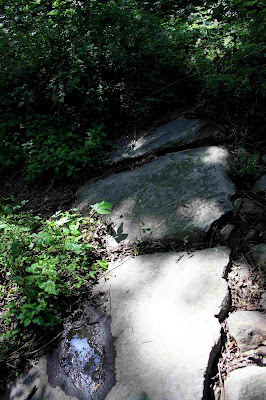By Beth Sullivan
It is spring, and we all know about
April showers…but these downpours! They are making life a little
difficult for some of us, but excellent for others. The drought is
over; the water table is high; amphibians are very happy.
Some projects need to be delayed due
to high water and very muddy conditions. The Hoffman Forest
restoration project is still on hold until conditions can dry out
more. Mud is terrible on heavy machinery. There are plans to do trail
work and bridge repair on several preserves. Our second work party on
Pequotsepos Brook was delayed, due to more down pours and flooding.
Paffard Woods trails are also due for maintenance and bridge
rebuilding, but with water so high it is nearly impossible. However,
a walk in the spring wet woods is quite wonderful. So we put aside
the projects and just enjoy the season as it is.
Avalonia preserves many beautiful
wetlands which are productive and critical habitats. Many protect
drinking water supplies. Wetlands also protect numerous species of
special concern. In the not too distant past, wetlands were allowed
to be filled and developed. Now they are protected and cherished.
 |
| Skunk cabbage flowers have been siting inconspicuously for months |
 |
| Some projects need to wait for the water to subside. |
In Paffard Woods
On a recent walk through Paffard
Woods, we had time to enjoy this lovely area with rocks and ridges
and a central beautiful brook. Generations ago the brook was named
Stony Brook and the water flowed freely from farther north in town,
all the way to Quanaduck Cove and into the Stonington Harbor. We have
some old maps that show the passage of the waters. Then a dam was
built to create what is known as Sylvia’s Pond. The main flow over
the dam took a more westward route, and kept the name Stony Brook. It
ultimately ends up in Stonington Harbor too, but in a different area.
A smaller outflow follows the old stream bed and is mostly referred
to as Sylvia’s Pond Brook. This is the lovely waterway flowing
through Paffard Woods Preserve.
The wetlands in here are pretty
typical for this area. They green up earliest in the spring. For
months the skunk cabbage flowers have been inconspicuously present
close to the ground. Those of us who know and love the plant, search
for it every early spring. Now the flowers are dwarfed by their
very conspicuous big green leaves that spread throughout the
wetlands. Alongside them are the false hellebore plants, looking a
bit like short corn stalks. Later, those that are in sunnier areas
will have interesting flowers. My favorites are the marsh marigolds,
or cowslips, that are glowing bright yellow right now. Along-side
them are lovely and delicate purple violets. Mother Nature knew about
complementary colors putting those two together.
We are also very excited to see
several large areas covered with the speckled leaves of the trout
lily, also called dog-toothed violet. These are very ephemeral
wildflowers, their bloom doesn’t last long, and even their leaves
die back after a few months. These and many other woodland
wildflowers take advantage of the open canopy to enjoy the sunshine
before the trees themselves leaf out. Spicebush is a shrub that is
also taking advantage of the early spring sun, to create a lacey haze
of soft yellow flowers at a higher level off the ground.
 |
| In this old map, Stony Brook runs its original course, before Sylvia's Pond was created. (Map of unknown providence.) |
 |
| The best spring combination- marsh marigolds, purple violets, and big green skunk cabbage leaves. |
Early Invasives
The only
sobering fact about observing these woodlands now, is that it is
obvious that the invasive plants are the very first to leaf out,
green up and take over. It is their successful strategy for bullying
their way to take over space in an area. Here in Paffard woods, the
greenery now is deceiving. Much of the mass of delicate foliage is
actually invasive Japanese Barberry. This plant is terrible:
impossible to walk through, impossible to manage, and a known habitat
for ticks.
Enjoy a walk along a trail in the
wild, wet woodlands. Look for the delicate flowers; look for the
hardy ones too. But stay out of the barberry. As we have all heard
before: please take only photos and do not pick the flowers. That’s
what a conservation mission is all about: the next generation of
people and flowers.
 |
| The fleeting beauty of a trout lily. |
 |
| Vernal wetlands are filled, and the yellow haze is created by the spicebush in bloom. |
 |
| All the green in this photo is foliage of Japanese Barberry. |
 |
| False Hellebore flowers are often overlooked but are quite pretty. |
Photographs by Beth Sullivan, unless
otherwise indicated.


























